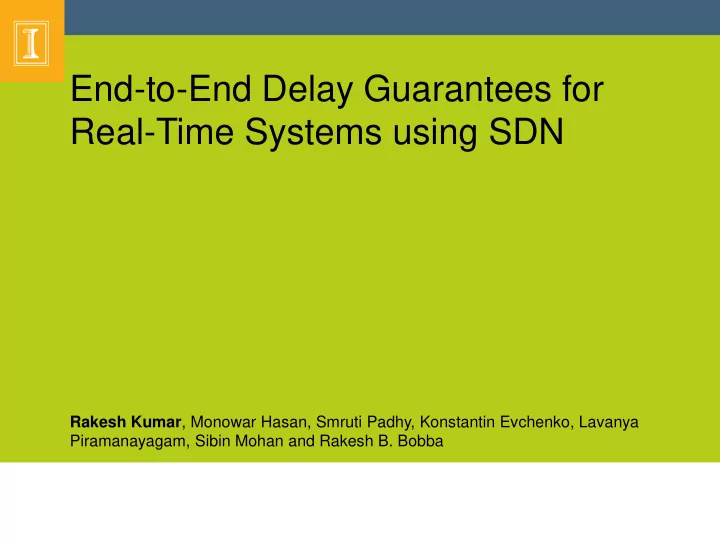

End-to-End Delay Guarantees for Real-Time Systems using SDN Rakesh Kumar , Monowar Hasan, Smruti Padhy, Konstantin Evchenko, Lavanya Piramanayagam, Sibin Mohan and Rakesh B. Bobba
Motivation • Real-time systems (RTS) require that timing critical applications’ packets from one host to another are delivered with a guaranteed upper bound on the end-to-end packet delay. – e.g. smart grids, avionics, automobiles, industrial control systems • Current approach: Separate networks for different classes of networks: • Higher costs and management overheads • Increased attack surface 2
Software Defined Networking (SDN) • Logically centralized Control Plane at Controller • Standardized Data Plane in commoditized Switches and Switch-Controller communication protocol. • Controller’s Northbound API enables find-grained control of individual flows in the network 3
Motivating Example • Two simultaneous flows with traffic at varying send rates. Two cases for queue configuration: – Each flow has a separate queue configured at 50 Mbps. – Both flows share a queue configured at 100 Mbps • The case with separate queues experiences lower average per-packet delay due to lack of interference. 4
Can the SDN Architecture Help? • The architecture offers no QoS guarantees for individual applications’ packet flow paths. • Questions: Can the SDN architecture enable computation • of flow paths that meet the QoS guaranteed specified by the network operators? Yes! Can the SDN architecture be used to allocate • resources for individual network flows? Sure... 5
Rest of the talk • Life of a packet in an SDN switch • Problem and Solution Overview • System Model • Multi-Constrained Path Problem • Evaluation • Conclusion and Future Work 6
Life of a Packet in an SDN switch • Each switch port contains multiple queues • The entire switch has a meter table • Flow Tables: Contain with rules match and option to select port, queue and meters. 7
Problem Statement f k f k SCADA Ethernet Controller Relay • Each flow ( f k ) with bandwidth and delay requirements given by B k and D k . • Allocation of n such flows so that their bandwidth and delay requirements are satisfied.
Solution Overview • Setup one flow at a time, starting with the flow with tightest delay requirements. • Access the system state (i.e. available resources, network topology) using the northbound API of the controller. • Finally: – Compute the flow path through the SDN such that its requirements are met. – Realization of path in the SDN by again using the northbound API. 9
System Model - I • Consider a graph ( V, E ) where: – Nodes ( V ) are all the ports in the network. – The edges ( E ) are come from: • Topology • If two ports are on the same switch, they are connected. 10
System Model - II • The total delay for a given path can be composed for the end-to-end path delay: • The total bandwidth consumed by the flow on the entire path is given by: 11
Multi-Constrained Path Problem • Delay Constraint: • Bandwidth Constraint: • NP-Complete but polynomial time heuristic available. 12
Path Realization • Intent represents actions performed on the packets in a given flow at an individual switch. • Each intent is 4-tuple given by: • Intents are realized with a flow rule and a corresponding exclusive queue. 13
Evaluation - Setup Randomly generated topologies by adding random links to a ring. 14
Evaluation: How many flows can be packed? • Random link delays between [25, 125] us. • For each flow, pick: – D k is a function of the randomly generated topologies. • Let D min = [200, 1000] us be the lowest delay for a flow. • Increment by D min /10 for each other flow. • For each choice of delay requirement and number of required flows, generated 250 random instances. – The acceptance ratio is the instances that successfully admitted all the required flows. 15
Evaluation: How many flows can be packed? 16
Evaluation: Can the flows be realized? • Link delay set to zero. • Added [1, 3] non-critical background flows. • Seven critical flows. • Each flow is CBR UDP traffic generated using netperf which lasts for 10 seconds: – D k : • D min : 100 us * diameter of the topology (i.e. ~4). • For others, increment by 10 us for each flow. 17
Evaluation: Can the flows be realized? 18
Conclusion and Discussion • COTS successfully used to allocate flows for highly critical RTS network traffic by exploiting opportunities presented by SDN. – Multiplexing the usage of a single queue by multiple flows remains an open problem. • The evaluation results are another instance of the “No Free Lunch Theorem”: – The acceptance ratio decreases either with increasing the number of flows or stringent end- to-end delay requirements. – What does the optimal allocation look like? 19
Recommend
More recommend